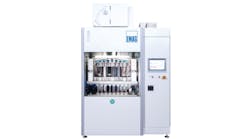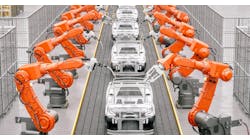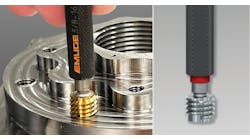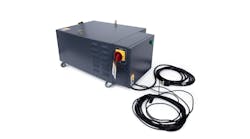AI-Based Predictive Quality Analytics
TIN-Coated Thread Gages
DWFRITZ AUTOMATION has developed the ZeroTouch measuring platform that uses multiple non-contact sensor technologies to measure in three dimensions, rapidly and in real time. ZeroTouch's proprietary software then creates a highly accurate dense 3D point cloud. In addition, by simplifying complicated programming procedures, ZeroTouch reduces the system configuration time to just a few hours saving substantial production time and costs.
“Quality control is critical in production operations,” explained David Mendez, v.p. of the ZeroTouch business unit. “Preparations, such as programming, as well as the measuring process itself, often take a great amount of time and result in high costs. In addition, inspection tasks requested for manufacturing often collide with other measurement requests such as those from other manufacturing lines, pre-production tests or even R&D.”
The measurement platform developed by DWFritz features a 5-axis architecture that captures millions of data points per second in a single scan to create a dense 3D point cloud. The system enables the rapid measurement of complex part geometries and precise inspection of the most complicated parts with high repeatability.
The system uses a planar air-bearing design that minimizes tolerance-stack error. The near-zero friction design provides extremely smooth, high-speed motion of precision stages and improves gage repeatability and reproducibility (GRR). In contrast, tactile probes typically operate at slower speeds as they require physical contact with the part surface.
During the development of ZeroTouch, special attention was given to problems that conventional CMMs face: obtaining quick, accurate and reproducible results to keep pace with manufacturing cycle times. Most traditional inspection systems have issues specifically with speed, ease-of-use and machine availability. As a result, traditional measurement technology does not lend itself to inline inspection or even fast sampling.
ZeroTouch’s architecture features five independent axes; a rotating bridge – Gonio like – equipped with multiple, non-contact sensors, including lasers and chromatic confocal sensors, which dramatically increase inspection speeds in measuring the entire part surface, as there is no sensor change time. The sensor bridge is configurable allowing for the most optimal and appropriate sensor selections to suit part geometries and surfaces, in addition to the complex dimensions being measured. Such innovations associated with a horizontal rotary table and 3 translation axes result in higher throughput of parts and increased capacity, enabling 100% in-line inspection rather than just sampling.
The innovative design of ZeroTouch addresses the challenge of repeatability in a hostile manufacturing environment. Since it can perform multiple measurements in parallel using different sensors, parts and assemblies can be analyzed significantly faster than a conventional CMM.
“The sensors can be configured to the specific GD&T measurements and the part, and in one scan the system can capture data points to create a high-density 3D model,” said Mendez. “This makes it possible to measure objects made of a wide variety of materials with complex geometries, including holes, undercuts, bevels, and surfaces, quickly and with micrometer precision. At the same time, the system provides very high reproducibility and repeatability of results.”
The three-dimensional point cloud can be analyzed immediately after the measurement process. Integrations to proven analysis tools enable the accurate comparison of the scan results with part CAD models or a reference part previously scanned and measured to not only check for geometric and dimensional tolerances, but for other previously undetected issues such as surface aspect defects. Using statistical process control (SPC), faults or outside-tolerance deviations can be quickly detected and appropriate reporting can be sent back to the MES. This could enable the adjustments of process parameters in upstream manufacturing processes to minimize rejects downstream.
The current system measures 240 x 150 x 190 cm (L x W x H) and weighs 3550 kg. It can measure parts measuring up to 300 x 300 x 300 mm and weighing up to 10 kg. It uses a high performance GPU PC with Intel Core i7-7700T processor, and two capacitive industrial monitors with touchscreens.
Learn more at www.dwfritz.com








